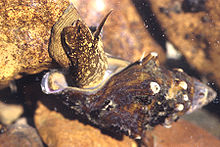
Littorinimorpha is a large order of snails, gastropods, consisting primarily of sea snails, but also including some freshwater snails and land snails.

Planorbidae, common name the ramshorn snails or ram's horn snails, is a family of air-breathing freshwater snails, aquatic pulmonate gastropod molluscs. Unlike most molluscs, the blood of ram's horn snails contains iron-based hemoglobin instead of copper-based hemocyanin. As a result, planorbids are able to breathe oxygen more efficiently than other molluscs. The presence of hemoglobin gives the body a reddish colour. This is especially apparent in albino animals.

Lymnaeidae, common name the pond snails, is a taxonomic family of small to large air-breathing freshwater snails, aquatic pulmonate gastropod mollusks, that belong to the clade Hygrophila.
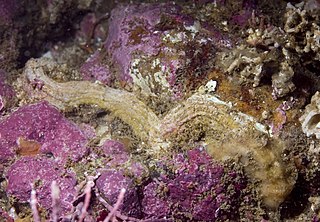
The Vermetidae, the worm snails or worm shells, are a taxonomic family of small to medium-sized sea snails, marine gastropod molluscs in the clade Littorinimorpha. The shells of species in the family Vermetidae are extremely irregular, and do not resemble the average snail shell, hence the common name "worm shells" or "worm snails".

Thiaridae, common name thiarids or trumpet snails, is a family of tropical freshwater snails with an operculum, aquatic gastropod mollusks in the superfamily Cerithioidea.

The Neotaenioglossa is a taxonomic name for a large group of mostly sea snails. The name was originally created by Haller in 1882. Ponder and Warén (1988), and Marquet (1997), assigned this name to the superorder Caenogastropoda. ITIS considers the order Neotaenioglossa to be a synonym of Cerithioidea Férussac, 1819 .

Amnicolidae is a family of small freshwater snails with a gill and an operculum, aquatic gastropod mollusks in the superfamily Rissooidea.

Provannidae is a family of deep water sea snails, marine gastropod mollusks in the superfmaily Abyssochrysoidea.
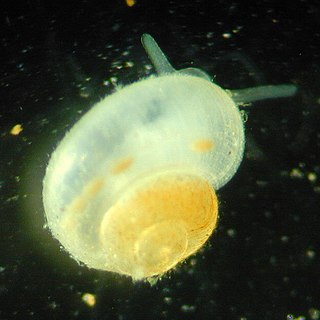
Cochliopidae is a family of small freshwater snails with gills and an operculum, aquatic gastropod mollusks.

The Cerithioidea is a superfamily of marine, brackish water and freshwater gastropod containing more than 200 genera. The Cerithoidea are included unassigned in the subclass Caenogastropoda. The original name of this superfamily was Cerithiacea, in keeping with common superfamily endings at the time.

Pachychilidae, common name pachychilids, is a taxonomic family of freshwater snails, gastropod molluscs in the clade Sorbeoconcha.

Dialidae, common name dialids, is a family of sea snails, marine gastropod molluscs in the clade Sorbeoconcha.
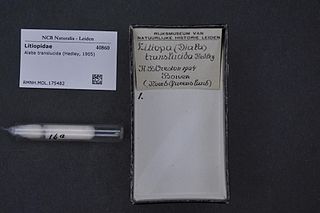
Litiopidae, common name litiopids, is a family of small sea snails, marine gastropod molluscs in the clade Sorbeoconcha.

Modulidae, common name modulids, is a family of small sea snails, marine gastropod molluscs in the superfamily Cerithioidea.
Scaliolidae, common name scaliolids, is a family of minute sea snails, marine gastropod molluscs or micromollusks in the superfamily Cerithioidea, the ceriths and their allies.

Freshwater snails are gastropod mollusks that live in fresh water. There are many different families. They are found throughout the world in various habitats, ranging from ephemeral pools to the largest lakes, and from small seeps and springs to major rivers. The great majority of freshwater gastropods have a shell, with very few exceptions. Some groups of snails that live in freshwater respire using gills, whereas other groups need to reach the surface to breathe air. In addition, some are amphibious and have both gills and a lung. Most feed on algae, but many are detritivores and some are filter feeders.
This overview lists proposed changes in the taxonomy of gastropods at the family level and above since 2005, when the taxonomy of the Gastropoda by Bouchet & Rocroi (2005) was published. In other words, these are recent updates in the way various groups of snails and slugs are classified.
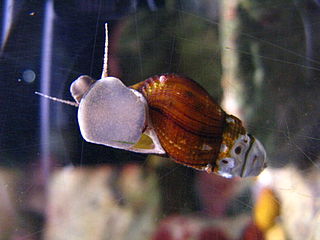
Semisulcospiridae, common name semisulcospirids, is a family of freshwater snails, aquatic gilled gastropod mollusks with an operculum, in the superfamily Cerithioidea.

Semisulcospira is a genus of freshwater snails with an operculum, an aquatic gastropod mollusks in the family Semisulcospiridae.
Obtortionidae is a family of sea snails, marine gastropod molluscs in the superfamily Cerithioidea, that is within the clade Cerithimorpha or in clade Sorbeoconcha.
